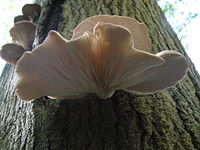
Photo from wikipedia
In this study, three psychrotolerant phenol-degrading yeast strains Candida subhashii (strain A011), Candida oregonenis (strain B021) and Schizoblastosporion starkeyi-henricii (strain L012) isolated from Rucianka peatland were examined to determine which… Click to show full abstract
In this study, three psychrotolerant phenol-degrading yeast strains Candida subhashii (strain A011), Candida oregonenis (strain B021) and Schizoblastosporion starkeyi-henricii (strain L012) isolated from Rucianka peatland were examined to determine which alternative metabolic pathway for phenol biodegradation is used by these microorganisms. All yeast strains were cultivated in minimal salt medium supplemented with phenol at 500, 750 and 1,000 mg l-1 concentration with two ways of conducting phenol biodegradation experiments: with and without the starving step of yeast cells. For studied yeast strains, no catechol 2,3-dioxygenase activities were detected by enzymatic assay and no products of catechol meta-cleavage in yeast cultures supernatants (GC-MS analysis), were detected. The detection of catechol 1,2-dioxygenase activity and the presence of cis,cis-muconic acid in the analyzed samples revealed that all studied psychrotolerant yeast strains were able to metabolize phenol via the ortho-cleavage pathway. Therefore, they may be tested in terms of their use to develop biotechnology for the production of cis,cis-muconic acid, a substrate used in the production of plastics (PET) and other valuable goods.
Journal Title: Enzyme and Microbial Technology
Year Published: 2020
Link to full text (if available)
Share on Social Media: Sign Up to like & get
recommendations!